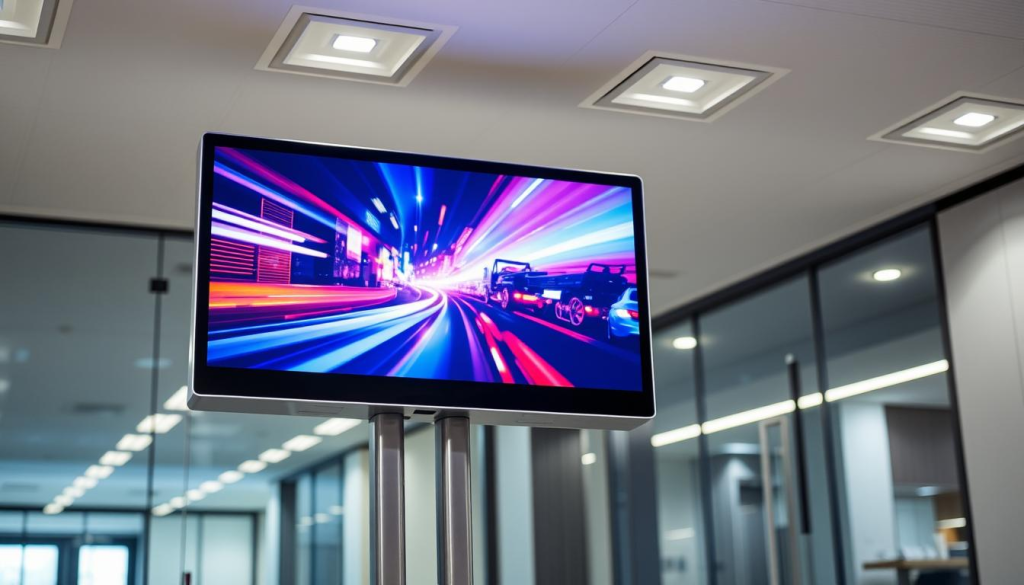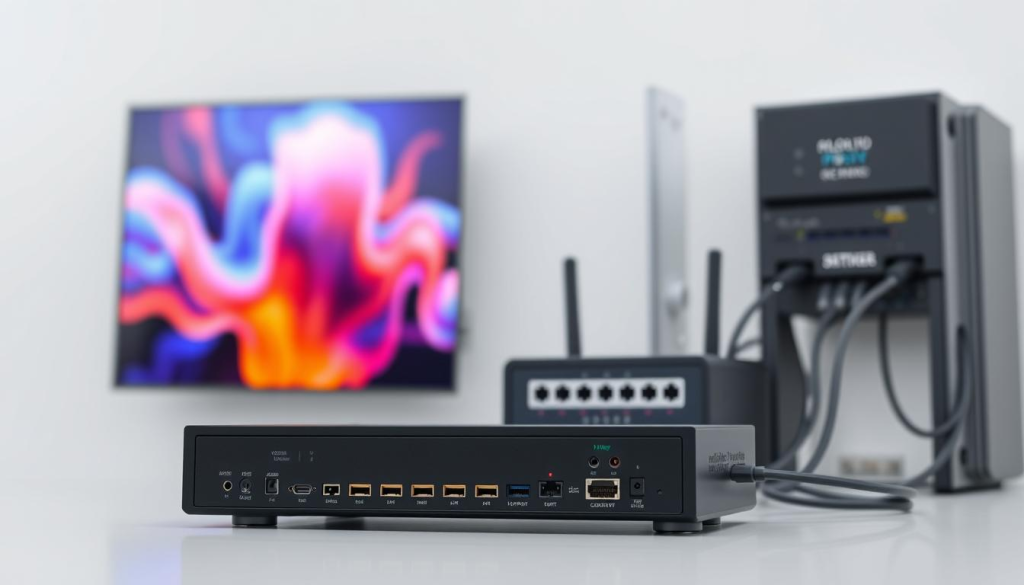The digital signage business is changing how companies talk to their audience. It offers dynamic, multimedia experiences that beat old static displays. The market is growing, opening up new chances for both new and old businesses in digital signage solutions.
These solutions use the latest digital signage technology and smart content management. This lets companies share their messages easily. More businesses want new ways to reach customers, and they need updates fast.
Using digital signage can really help your brand stand out and boost sales. The market is expected to grow a lot, making good digital signage strategies key to getting noticed.

Key Takeaways
- Digital signage increases brand awareness by 47%.
- Cloud-based systems allow for instant messaging adaptations to reflect current promotions.
- Multimedia capabilities enhance audience engagement and interaction.
- Businesses save costs by reducing reliance on printed marketing materials.
- Effective for improving communication within corporate environments and educational institutions.
- Regular analysis of digital signage performance can lead to improved content strategies and business growth.
Understanding Digital Signage Solutions
Digital signage is a modern way for businesses to connect with people through electronic displays. These displays show multimedia content in different places. It makes customer interaction better, communication smoother, and promotional materials more engaging.
This technology has grown a lot. It has moved from simple LED displays to advanced systems. Now, it can update in real-time and connect with many content sources.
Definition and Importance
Digital signage solutions let businesses show videos, images, and interactive content well. Brands have seen big benefits, like Christian Dior’s 15% sales boost from daily promotions on electronic signs. Starbucks saw a 25% increase in foot traffic with advertising monitors.
These examples show how important digital signage is. It’s key in retail where keeping customers engaged is vital.
Evolution of Digital Signage Technology
The technology behind digital signage has evolved a lot. Now, it includes advanced displays like LED video walls and LCD monitors. This lets brands communicate better.
Interactive elements like touchscreens make shopping more fun. Customers can interact with content directly. This improves their shopping experience.
Businesses also get real-time updates from digital wayfinding systems. These systems guide users based on their input. This immediate information boosts foot traffic and improves marketing strategies.
Benefits of the Digital Signage Business
The digital signage business offers many advantages for companies. It helps improve customer engagement through dynamic visual content. This content grabs attention and encourages people to interact, making the shopping experience better.
This interaction boosts customer loyalty and satisfaction. It also drives sales.
Enhanced Customer Engagement
Digital signage changes how businesses talk to customers. It uses dynamic content and interactive elements to keep people engaged. This builds stronger emotional bonds with the brand.
Companies that use digital signage see a 33% rise in sales. This shows how important customer engagement is for making money.
Real-Time Updates and Flexibility
Digital signage is great for making quick changes. Businesses can update messages and displays in minutes. This means no more printing and distributing materials.
It saves money on materials and distribution. Plus, it lets businesses manage content across many locations. This ensures everything stays consistent and resources are used well.
Cost-Effective Marketing Solution
Digital signage is a smart way to market. It saves money by reducing the need for printed materials. It promotes products and services efficiently.
Using digital displays can pay off quickly. Businesses see more people coming in and staying longer. Digital signage’s appeal leads to more sales and customer interactions, helping businesses make a lot of money.
Applications of Digital Signage in Various Industries
Digital signage is used in many industries. It helps with communication that fits each industry’s needs. This technology makes it easier for businesses to talk to their audience, leading to better results.
Retail and Consumer Engagement
In retail, digital signage makes it easier to show off products and deals. Stores see a 30% boost in return on investment with digital displays. These displays grab attention and update prices and stock in real-time, boosting sales and customer interaction.
Corporate Communications
Companies use digital signage to share news and updates quickly. It keeps employees informed, making the workplace more connected. This leads to better access to information and happier employees.
Healthcare Information Sharing
In healthcare, digital signage helps with patient communication. It shows wait times and appointment reminders, making the patient experience better. Facilities see shorter wait times and happier patients, showing its importance in healthcare.
Transportation and Travel Information
Transportation digital signage makes travel smoother by sharing real-time info. It cuts down complaints about delays by 30%. Digital signs help authorities share important updates, making travel more efficient and satisfying.
| Industry | Application | Benefit |
|---|---|---|
| Retail | Dynamic displays of promotions | Increased sales, improved customer engagement |
| Corporate | Internal announcements | Better employee connection and information access |
| Healthcare | Patient information and wait times | Enhanced patient experience, reduced wait times |
| Transportation | Real-time travel data | Improved traveler satisfaction, reduced complaints |
Key Components of a Digital Signage System
A digital signage system has key parts that work together. They help share information in a clear way. Each part is important for showing messages well and keeping people interested.
Display Technologies: Displays and Monitors
Today’s displays include high-definition LCD panels and bright LED screens. They are made to work all day, every day. With better resolutions like 4K and 8K, images look amazing.
Interactive touchscreens let people engage with messages. This makes watching signs more fun and interactive.
Media Players: The Heart of Digital Signage
Media players are the brain of digital signage. They connect to screens and show content as planned. They work with many display types, meeting different business needs.
They make sure everything runs smoothly and works well with other hardware. This makes updating content easy, even from far away.
Content Management Systems (CMS)
Good content management is key for digital signage. Cloud-based systems let users manage content easily from anywhere. The EnGage CMS makes everything work together better.
Businesses can change content for different times or places. This makes promotions more effective and keeps messages consistent.

Merging Digital Signage with Digital Marketing Strategies
Digital signage marketing strategies can greatly increase business visibility and customer interaction. By combining digital signage with smart marketing, companies can create a lively presence. This presence improves the customer experience. A key part of this mix is social media integration, which lets brands show live feeds and talk to customers right away.
Integrating with Social Media and Live Feeds
Adding social media to digital signage makes ads interactive. Showing live social media feeds grabs attention and gets customers involved. Research finds that 60% of people are more likely to connect with brands that are active on social media.
This interaction boosts digital signage’s effectiveness. It creates a smooth experience across all channels, making customers happier and more loyal.
Utilizing Analytics for Content Optimization
Using analytics to analyze digital signage content is key to better engagement and sales. Advanced tools help track how well content is doing. With this info, brands can update their signs to match current trends, making them more effective.
Personalized experiences, based on data, can really improve customer interaction. Companies can tailor ads to what their audience likes. This approach can significantly raise sales, using digital signage to its fullest marketing power.
Exploring Digital Signage Technologies
Digital signage technologies have changed how businesses talk to their audience. New AI and augmented reality tools offer ways to make viewing better and content more relevant.
AI in Digital Signage Solutions
AI in digital signage is changing how businesses talk to customers. It analyzes who’s watching and what they do in real-time. This helps make content that really speaks to people.
Retailers can use this to suggest products that fit what customers like. This makes shopping more fun and effective. It helps businesses understand what customers want better.
AI also lets businesses update their signs right away. With digital signage platforms, changes can be made from anywhere with internet. This means messages can be updated based on things like how busy it is or what’s trending.
This helps businesses make their ads work better, leading to more sales when it’s busy.
Augmented Reality and Interactive Displays
Augmented reality displays make shopping more fun by letting customers try things out in new ways. They can try on clothes or see how furniture fits in their home. This makes shopping more engaging and helps people make better choices.
Interactive displays are great for things like finding your way in big places. They make it easy to get around and help people connect more with brands. This opens up new ways for businesses to market themselves.
| Technology | Benefits | Applications |
|---|---|---|
| AI in Digital Signage | Real-time analytics, personalized content delivery | Retail, advertising, corporate communications |
| Augmented Reality Displays | Immersive experiences, product visualization | Retail, education, entertainment |
| Interactive Displays | Improved engagement, user navigation | Malls, airports, museums |
Digital signage keeps getting better, giving businesses ways to connect with customers. Using AI and augmented reality makes interactions better and gives businesses an edge in the digital world.
Launching a Successful Digital Signage Business
Starting a digital signage business needs careful planning. You must know your target market and the key infrastructure for success. Understanding your clients’ demographics, preferences, and needs is key. This knowledge helps craft messages that connect with your audience and meet their expectations.
Identifying Your Target Market
Finding your target market for digital signage means looking at different sectors. Retail, healthcare, transportation, and corporate settings are all good places to start. Each one has its own needs; for example, retailers want to engage customers, while companies need to share information. Knowing these differences helps you tailor your approach.
Setting Up the Necessary Infrastructure
The digital signage setup includes several important parts. You’ll need:
- Display Technologies: A screen size of at least 42 inches is best, placed 7-10 feet away for good viewing.
- Media Players: These are the heart of your system, making sure content plays smoothly.
- Content Management Systems: A strong CMS makes scheduling and updates easy, using real-time data and presets.
A reliable internet connection and good technical support are also essential. Your content should focus on visuals to grab attention quickly. Businesses using digital signage see better engagement and sales, with results varying by industry and strategy.
Challenges in the Digital Signage Industry
The digital signage industry is growing fast, but it faces many challenges. Overcoming these hurdles is key to making digital displays work well and getting a good return on investment.
Maintaining Content Relevance
Keeping up with trends and what viewers like is vital. Businesses need to update their displays often to match new promotions and interests. A study shows 70% of users find managing content a big challenge.
Understanding the audience through surveys and data helps a lot. 65% of marketers say knowing who their audience is makes digital signage more effective. If content isn’t updated, viewers might lose interest, hurting the investment.
Managing Hardware and Software Integration
Dealing with technical issues is a big problem in digital signage. Problems like equipment failures can cause a lot of downtime and frustration. About 50% of companies say they can’t afford to fix these problems.
Regular upkeep is key to avoid system crashes, outdated content, and security issues. Without it, up to 60% of digital signage systems could be affected. Having a reliable network is also critical, as 80% of failures are due to bad connections.
Good training programs help users feel more confident and work more efficiently. This makes digital signage more effective.

| Challenge | Statistic |
|---|---|
| Content Management Difficulties | 70% of users report it as a major challenge |
| Importance of Audience Analysis | 65% of marketers say it improves effectiveness |
| Budget Constraints | 50% of organizations cite it as a barrier |
| Connectivity Issues | 80% of failures are due to poor internet |
| Training Impact on Efficiency | 30% increase in user confidence with training |
Future Trends in Digital Signage Technology
The digital signage world is set for big changes, thanks to cloud-based solutions. These new systems let businesses manage content from anywhere, making things easier and more efficient. The market is growing fast, with a 8.1% annual growth rate expected from 2024 to 2030. It’s now worth USD 26.76 billion, and more companies are seeing the value of digital displays.
The Shift Towards Cloud-Based Solutions
Cloud technology is changing digital signage for the better. It offers a pay-as-you-go model that cuts down on initial costs. This lets more businesses grow without breaking the bank.
Using these cloud systems makes managing content easier. They also work well with cool tech like AI and biometric readers. Companies are choosing these systems for their ability to create personalized marketing, which improves the customer experience.
Incorporating Sustainability in Digital Signage
At the same time, there’s a big push for sustainability in digital signage. Over 30% of digital signage companies are going green. They’re using solar power and energy-saving devices to cut down on energy use by up to 75%.
This focus on sustainability shows a commitment to being eco-friendly. It makes digital signage not just a marketing tool but also a way to help the environment.
FAQ
What is digital signage?
Digital signage uses electronic displays to show multimedia content. This includes images, videos, and text. It aims to grab attention in different places. It uses advanced tech to make experiences dynamic and engaging.
What are the primary benefits of using digital signage solutions?
The main benefits are better customer engagement and real-time updates. It also offers cost-effective marketing. This helps reduce the need for printed materials.
How does digital signage differ between indoor and outdoor applications?
Outdoor digital signage needs weather-resistant displays and high brightness. This is to fight against sunlight and weather. Indoor signage focuses on vivid graphics and interactive content without weather worries.
What components are essential for a digital signage system?
Important parts include display technologies like LED monitors and projectors. Media players drive the content. A strong content management system (CMS) is also key for creating and scheduling content.
How can businesses integrate digital signage with their digital marketing strategies?
Businesses can blend digital signage with marketing by adding social media feeds and live data. This makes content dynamic and engaging. Analytics help improve content based on viewer feedback.
What role does artificial intelligence play in digital signage?
AI makes digital signage better by personalizing content. It targets specific audiences based on demographics and context. This leads to more relevant messaging and better viewer engagement.
What challenges do businesses face in the digital signage industry?
Challenges include keeping content fresh and managing hardware and software. It’s also important to train employees well. This ensures the system works smoothly.
What future trends should we expect in digital signage technology?
Expect a move to cloud-based solutions for easier content management. There will be more focus on sustainable, energy-efficient tech. Also, look for advancements in content delivery that use real-time data and interactive experiences.